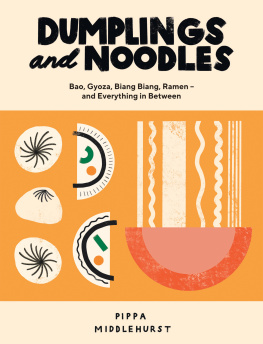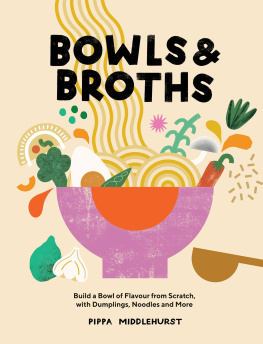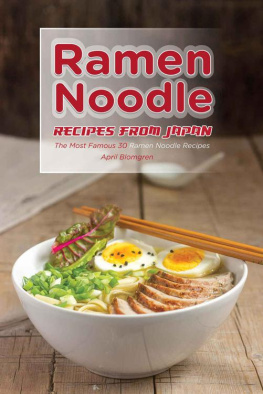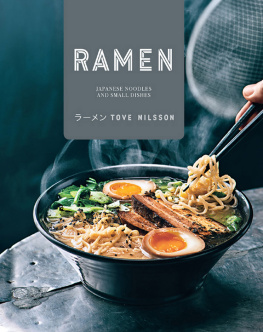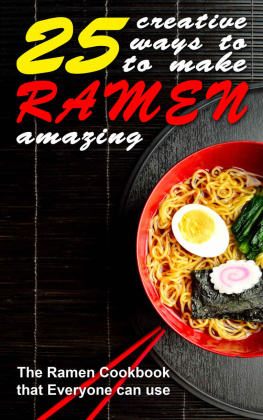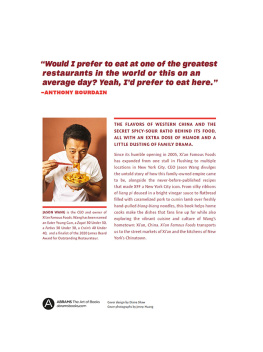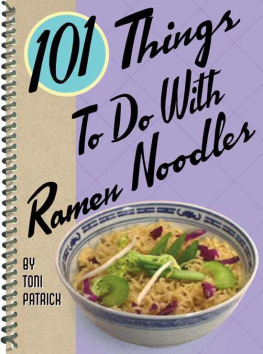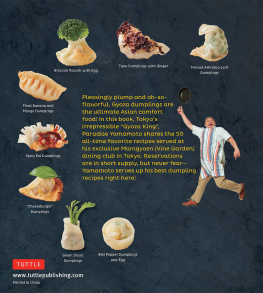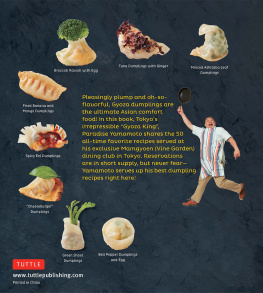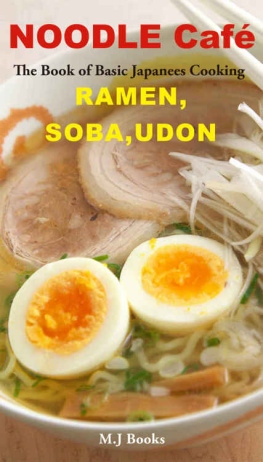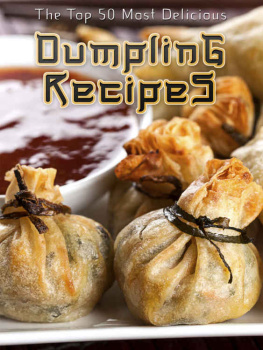Pippa Middlehurst - Dumplings and noodles : bao, gyoza, biang biang, ramen -- and everything in between
Here you can read online Pippa Middlehurst - Dumplings and noodles : bao, gyoza, biang biang, ramen -- and everything in between full text of the book (entire story) in english for free. Download pdf and epub, get meaning, cover and reviews about this ebook. year: 2020, genre: Home and family. Description of the work, (preface) as well as reviews are available. Best literature library LitArk.com created for fans of good reading and offers a wide selection of genres:
Romance novel
Science fiction
Adventure
Detective
Science
History
Home and family
Prose
Art
Politics
Computer
Non-fiction
Religion
Business
Children
Humor
Choose a favorite category and find really read worthwhile books. Enjoy immersion in the world of imagination, feel the emotions of the characters or learn something new for yourself, make an fascinating discovery.
- Book:Dumplings and noodles : bao, gyoza, biang biang, ramen -- and everything in between
- Author:
- Genre:
- Year:2020
- Rating:3 / 5
- Favourites:Add to favourites
- Your mark:
- 60
- 1
- 2
- 3
- 4
- 5
Dumplings and noodles : bao, gyoza, biang biang, ramen -- and everything in between: summary, description and annotation
We offer to read an annotation, description, summary or preface (depends on what the author of the book "Dumplings and noodles : bao, gyoza, biang biang, ramen -- and everything in between" wrote himself). If you haven't found the necessary information about the book — write in the comments, we will try to find it.
Pippa Middlehurst: author's other books
Who wrote Dumplings and noodles : bao, gyoza, biang biang, ramen -- and everything in between? Find out the surname, the name of the author of the book and a list of all author's works by series.
Dumplings and noodles : bao, gyoza, biang biang, ramen -- and everything in between — read online for free the complete book (whole text) full work
Below is the text of the book, divided by pages. System saving the place of the last page read, allows you to conveniently read the book "Dumplings and noodles : bao, gyoza, biang biang, ramen -- and everything in between" online for free, without having to search again every time where you left off. Put a bookmark, and you can go to the page where you finished reading at any time.
Font size:
Interval:
Bookmark:


Publishing Director Sarah Lavelle
Assistant Editor Stacey Cleworth
Art Direction and Design Emily Lapworth
Cover and Illustrations Han Valentine
Photographers India Hobson & Magnus Edmondson
Food Stylist Libby Silbermann
Prop Stylist Louie Waller
Head of Production Stephen Lang
Production Controller Nikolaus Ginelli
First published in 2020 by Quadrille,
an imprint of Hardie Grant Publishing
Reprinted in 2020
10 9 8 7 6 5 4 3 2
Quadrille
5254 Southwark Street
London SE1 1UN
quadrille.com
Text Pippa Middlehurst 2020
Photography India Hobson
& Magnus Edmondson 2020
Design and layout Quadrille 2020
All rights reserved. No part of the book may be reproduced,
stored in a retrieval system, or transmitted in any form or by any
means, electronic, electrostatic, magnetic tape, mechanical,
photocopying, recording or otherwise, without the prior
permission in writing of the publisher.
The rights of Pippa Middlehurst to be identified as the
author of this work have been asserted by her in accordance
with the Copyright, Design and Patents Act 1988.
Cataloguing in Publication Data: a catalogue record for
this book is available from the British Library.
978 1 78713 569 7

This book is a personal collection of my favourite recipes, from Taiwan, China and Japan. They are dishes that I regularly cook for myself and my family at home. I wanted to create a book with recipes that are achievable and approachable a book I wish had existed when I began cooking Asian food. They have mostly been transcribed from my scratty, soy-splattered kitchen notebooks, filled with doodles and notes only legible to myself and made this way because I once thought nobody would ever see these recipes, but me. Yet here we are!
My love of cooking Asian food began when I was a young child. My maternal grandad, a toweringly tall, well-travelled, proud Irish Catholic, used to take me and my brothers for dim sum. He was a lover of fine things and his keen eye for the very best meant that my first experiences of Chinese food were far removed from the typical red gloop that most children in the north-west of England would have been introduced to at that age. I vividly remember him ordering from the steaming dim sum trolleys with absolute confidence, considering we were the only non-Chinese family in the restaurant. I can still feel the curiosity that was sparked in me as a six-year-old as bamboo baskets were set down on our table. My amusement at my brothers faces as they tried egg drop soup for the first time and hated it! It was the new and unfamiliar flavours and textures in this food that they found so repulsive, but which I loved so much.
Further excitement was to follow upon the discovery of a wholesale Asian supermarket just beneath the restaurant. The rows and rows of strange ingredients filled me with a childlike sense of wonder and giddiness that has never really left me, even to this day. I still go to the same Asian supermarket, and its still one of my favourite places to visit. The aisles filled with different wares are so familiar to me now, I could navigate them with my eyes closed.
When I was around 12 or so, I found a recipe in a magazine for a simple stir-fry. Rather than resort to a packet of stir-fry sauce, I decided to give the recipe a try. I used what we had in the cupboards a cheap supermarket soy sauce that I mixed with toasted sesame oil. It instantly took me back to those Chinese meals with grandad. It was the flavours that I cherished was it possible that I could recreate them at home? I already knew how to cook; my granny had taught me basic cookery skills how to make a rice pudding, how to roast a chicken but my pursuit of Asian home cooking began at that moment.
I taught myself using the classics Ken Homs Simple Asian Cookery, Ching-He Huangs Chinese Food Made Easy. But I wanted more more authenticity, more of those strange textures, more of those unusual ingredients. Stinky tofu? Doubanjiang? What were they used for and what did they taste like? My quest for authenticity lead me to Fuchsia Dunlop and online blogs. I found myself regularly having to translate new languages online and decipher recipes written in the authors mother tongue. And I knew exactly where I could find the obscure ingredients they called for.
As I practised and learned, gradually I became familiar with each of the ingredients on those shelves and my fascination with Asian cuisine expanded from Chinese, to Japanese, Taiwanese, Korean, Thai, Vietnamese and Malay. Even today, if I come across ingredients Im unfamiliar with, I simply cannot walk past them. I seek out and collect the most authentic foods for my recipes: the best Taiwanese Shaoxing rice wine; aged Japanese soy; imported Chinese doubanjiang. I became something of a purist, which I guess I should attribute to grandad.

As my knowledge grew, so did my arsenal of ingredients and my stash of dog-eared notebooks. Eventually, I ended up with my very own cupboard in my dads kitchen The Curly Cupboard, he would call it, after his nickname for me. When the cupboard door opened, you were overwhelmed by a wave of pungency that only I seemed to find pleasurable. He would keep it firmly closed. I would experiment on dad and my little brother, who would dutifully try whatever I had presented them with, while I eyeballed them sternly from the bomb site I had created in the kitchen. I once fed them chicken breast coated in whole Sichuan peppercorns. Dads response was memorable: Oh Curly, my mouth has gone a bit numb...
Parallel to this blossoming romance with Asian cuisine was school and university, with exams and decisions about what to do next. Despite my love of food, music and arts, I always knew that I wanted a career in science. Something about the way my mind works processes, facts, methodology meant there was no other choice for me. I graduated from university with a degree in microbiology and molecular biology.
This love of methodology and processes combined with my fascination with Asian cuisine is what has inspired my start-to-finish approach to cooking. Preparing every last component, from beginning to end. Complete control over every aspect of a dish. I wanted authenticity and I wanted to recreate it myself. I wanted to know what was happening to my ingredients on a molecular level and how I could harness that to improve texture and flavour. The kitchen became my at-home lab. This hunger for authentic technique and process would eventually lead me to a cookery school in Lanzhou, China, where I learned how to make and hand pull la mian noodles in the traditional way flour, water, salt and hours of manual labour.
Some of the recipes in this book are in pursuit of authenticity and tradition, while others are the result of a weeknight after-work cupboard raid that proved fruitful. Some are for eating in bed, alone, and others are for sharing with friends. Some of them are approachable recreations of street foods I discovered while travelling and others are a homage to the time-tested favourites from that dim sum restaurant I would frequent with my grandad all those years ago.
Font size:
Interval:
Bookmark:
Similar books «Dumplings and noodles : bao, gyoza, biang biang, ramen -- and everything in between»
Look at similar books to Dumplings and noodles : bao, gyoza, biang biang, ramen -- and everything in between. We have selected literature similar in name and meaning in the hope of providing readers with more options to find new, interesting, not yet read works.
Discussion, reviews of the book Dumplings and noodles : bao, gyoza, biang biang, ramen -- and everything in between and just readers' own opinions. Leave your comments, write what you think about the work, its meaning or the main characters. Specify what exactly you liked and what you didn't like, and why you think so.

